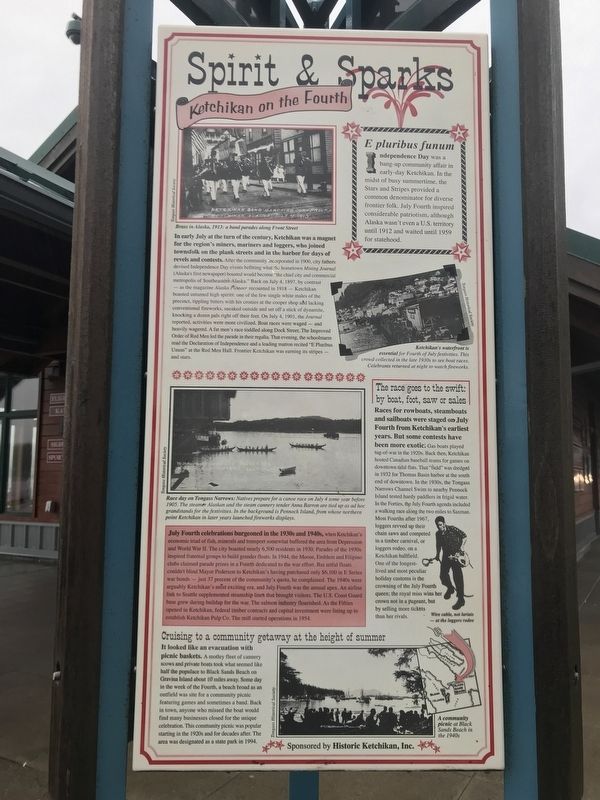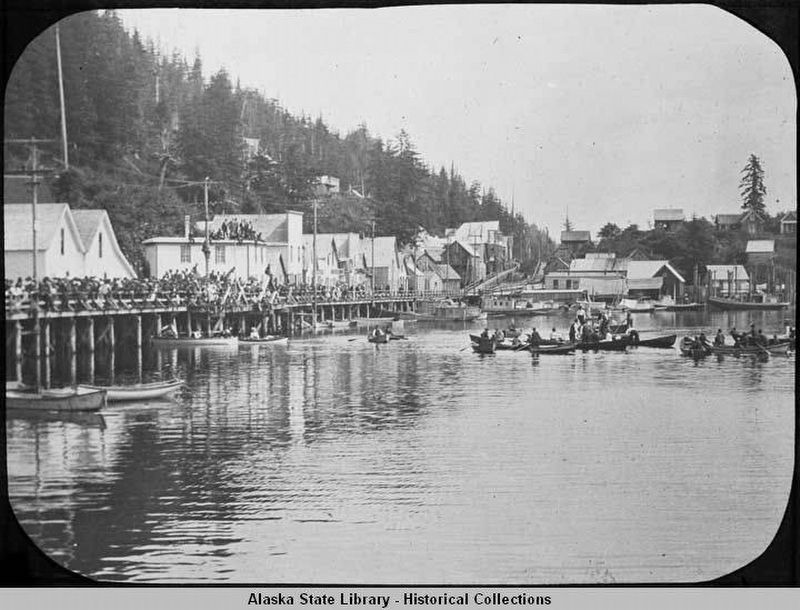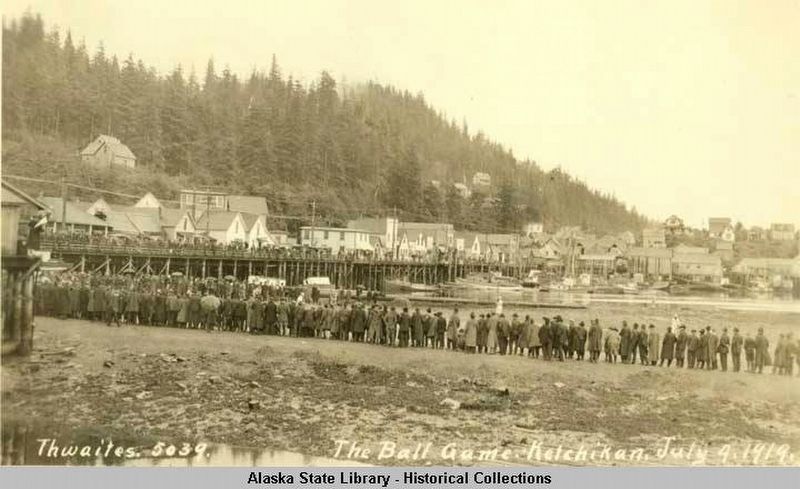Ketchikan in Ketchikan Gateway Borough, Alaska — Northwest (North America)
Spirit & Sparks
Ketchikan on the Fourth
Independence Day was a bang-up community affair in early-day Ketchikan. In the midst of busy summertime, the Stars and Stripes provided a common denominator for diverse frontier folk. July Fourth inspired considerable patriotism, although Alaska wasn't even a U.S. territory until 1912 and waited until 1959 for statehood.
In early July at the turn of the century, Ketchikan was a magnet for the region's miners, mariners and loggers, who joined townsfolk on the plank streets and in the harbor for days of revels and contests. After the community incorporated in 1900, city fathers devised Independence Day events befitting what the hometown Mining Journal (Alaska's first newspaper) boasted would become “the chief city and commercial metropolis of Southeastern Alaska.” Back on July 4, 1897, by contrast — as the magazine Alaska Pioneer recounted in 1918 — Ketchikan boasted untamed high spirits: one of the few single white males of the precinct, tippling bitters with his cronies at the cooper shop and lacking conventional fireworks, sneaked outside and set off a stick of dynamite, knocking a dozen pals right off their feet. On July 4, 1901, the Journal reported, activities were more civilized. Boat races were waged — and heavily wagered. A fat men's race toddled along Dock Street. The Improved Order of Red Men led the parade in their regalia. That evening, the schoolmarm read the Declaration of Independence and a leading matron recited “E Pluribus Unum” at the Red Men Hall. Frontier Ketchikan was earning its stripes — and stars.
The race goes to the swift: by boat, foot, saw or sales
Races for rowboats, steamboats and sailboats were staged on July Fourth from Ketchikan's earliest years. But some contests have been more exotic: Gas boats played tug-of-war in the 1920s. Back then, Ketchikan hosted Canadian baseball teams for games on downtown tidal flats. That “field” was dredged in 1932 for Thomas Basin harbor at the south end of downtown. In the 1930s, the Tongass Narrows Channel Swim to nearby Pennock Island tested hardy paddlers in frigid water. In the Forties, the July Fourth agenda included a walking race along the two miles to Saxman. Most Fourths after 1967, loggers revved up their chain saws and competed in a timber carnival, or loggers rodeo, on a Ketchikan ballfield. One of the longest-lived and most peculiar holiday customs is the crowning of the July Fourth queen; the royal miss wins her crown not in a pageant, but by selling more tickets than her rivals.
July Fourth celebrations burgeoned in the 1930s and 1940s, when Ketchikan's economic triad of fish, minerals and transport somewhat buffered the area from Depression
and World War II. The city boasted nearly 6,500 residents in 1930. Parades of the 1930s inspired fraternal groups to build grander floats. In 1944, the Moose, Emblem and Filipino clubs claimed parade prizes in a Fourth dedicated to the war effort. But artful floats couldn't blind Mayor Pederson to Ketchikan's having purchased only $6,100 in E Series war bonds — just 37 percent of the community's quota, he complained. The 1940s were arguably Ketchikan's most exciting era, and July Fourth was the annual apex. An airline link to Seattle supplemented steamship lines that brought visitors. The U.S. Coast Guard base grew during buildup for the war. The salmon industry flourished. As the Fifties opened in Ketchikan, federal timber contracts and capital investment were lining up to establish Ketchikan Pulp Co. The mill started operations in 1954.
Cruising to a community getaway at the height of summer
It looked like an evacuation with picnic baskets. A motley fleet of cannery scows and private boats took what seemed like half the populace to Black Sands Beach on Gravina Island about 10 miles away. Some day in the week of the Fourth, a beach broad as an outfield was site for a community picnic featuring games and sometimes a band. Back in town, anyone who missed the boat would find many businesses closed for the unique celebration. This community picnic was popular
starting in the 1920s and for decades after. The area was designated as a state park in 1994.
Captions (top to bottom)
• Brass in Alaska, 1913: a band parades along Front Street. Tongass Historical Society
• Ketchikan's waterfront is essential for Fourth of July festivities. This crowd collected in the late 1930s to see boat races. Celebrants returned at night to watch fireworks. Tongass Historical Society
• Race day on Tongass Narrows: Natives prepare for a canoe race on July 4 some year before 1905. The steamer Alaskan and the steam cannery tender Anna Barron are tied up as ad hoc grandstands for the festivities. In the background is Pennock Island, from whose northern point Ketchikan in later years launched fireworks displays. Tongass Historical Society
• Wire cable, not lariats — at the loggers rodeo.
• A community picnic at Black Sands Beach in the 1940s. Tongass Historical Society
Erected by Historic Ketchikan, Inc.
Topics. This historical marker is listed in these topic lists: Industry & Commerce • Parks & Recreational Areas • Patriots & Patriotism • Sports.
Location. 55° 20.444′ N, 131° 38.784′ W. Marker is in Ketchikan, Alaska, in Ketchikan Gateway Borough. Marker is at the intersection of Front Street and Spruce Mill Way, on the right when traveling south on Front Street. Touch for map. Marker is at or near this postal address: 131 Front Street, Ketchikan AK 99901, United States of America. Touch for directions.
Other nearby markers. At least 8 other markers are within walking distance of this marker. South Front Street (here, next to this marker); Trials by Fire (here, next to this marker); Ketchikan Waterfront from Pennock Island, 1905 (within shouting distance of this marker); When 'Steam was Queen' (within shouting distance of this marker); Proud Canoes & Coastal Traders (within shouting distance of this marker); Star-crossed Square Riggers (within shouting distance of this marker); Tongass Trading Company (about 400 feet away, measured in a direct line); The Gilmore Hotel (about 600 feet away). Touch for a list and map of all markers in Ketchikan.
Credits. This page was last revised on September 16, 2021. It was originally submitted on September 16, 2021, by Duane and Tracy Marsteller of Murfreesboro, Tennessee. This page has been viewed 201 times since then and 11 times this year. Photos: 1, 2, 3. submitted on September 16, 2021, by Duane and Tracy Marsteller of Murfreesboro, Tennessee.


